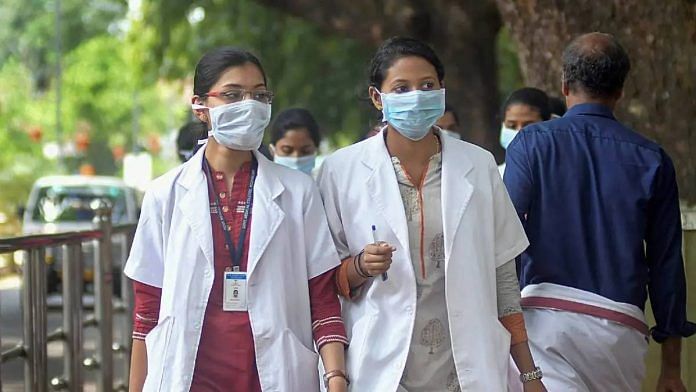New Delhi: A new regulation explicating policies related to working hours, weekly offs and leaves for post-graduate students in medical colleges is likely to be released in the coming weeks, a senior National Medical Commission (NMC) official has said.
PG students in medical colleges work as resident doctors at hospitals attached with the institution and are governed under the Postgraduate Medical Education (Amendment) Regulations, 2018. As of now, the regulations do not define working hours or conditions for resident doctors.
“A new PG regulation draft is in the final stage and will be released very soon,” Dr Yogender Malik, NMC spokesperson and member of the Ethics and Medical Registration Board under the commission said Tuesday during an interaction with media persons. “It will address issues like working hours for residents, ragging and ways to improve their work-related stress.”
According to Dr Aviral Mathur, a PG student at Delhi’s Maulana Azad Medical College and president of the Federation of Resident Doctors Association (Forda), for many residents across various hospitals and departments, working even 80 hours or beyond per week is normal.
Forda — the largest association of resident doctors in India — in a representation given to the NMC last month had demanded that resident doctors should not be made to work beyond 60 hours a week and be given at least 30 leaves every year apart from a fixed weekly off. They are currently given 20 leaves annually in most institutions.
“While we understand that it may not be possible to make residents work less than 48 hours a week, given the load of patients in hospitals and in the interest of their own training, they should also not be made to work more than 60 hours weekly,” Mathur told ThePrint.
The situation is particularly worse for residents in some departments — such as surgery, emergency, medicine and obstetrics and gynecology — which typically see the highest load of patients, he added.
A senior member of the NMC’s PG board, who wished to not be named, said that the regulator intended to bring in “large systemic changes” in order to address the issue of growing distress among resident doctors.
“It is a reality that across medical colleges, residents work under duress and need better working and training conditions. That’s why we are trying to bring in sweeping changes in the PG regulation which, as of now, is the one first introduced in 1992 and which has undergone some amendments but hasn’t brought in major policy changes,” the official told ThePrint.
Additionally, he said, “toxic work culture” in some institutions is also a concern.
According to Mathur, there have been instances when in some hospitals some residents have to be on round the clock duty for up to five days, and claimed that some institutions even deny a weekly off to residents for several weeks.
“And these things happen not through decisions taken by the hospital’s administrative department, but by seniors and departments at a very local level. It leads to severe burnout among PG students,” Mathur said.
Mental health issues and instances of violence against doctors, mainly residents, are also seen routinely in hospitals with “poor work culture for residents”, he added.
A study published in the Indian Journal of Psychiatry last year showed that between 2010 and 2019 there were 358 deaths by suicide by medical professionals in 10 years, 70 percent of which occurred before the age of 30 years, and 26 percent of which had shown warning signs prior to the act.
It also showed that there were 30 suicidal deaths among medical professionals between 2016 and 2019, 80 percent of which occurred in those younger than 40 years.
“Anesthesiology as a specialty had the highest number of victims,” the study said. “Academic stress, marital discord and mental health problems (mainly depression) were reported as the most important causes,” the study added.
Also read: Air pollution linked to surging Type 2 diabetes cases, finds 7-yr study of Delhi & Chennai residents
Concerns over incidents of suicide
In early October this year, a 27-year old anesthesia resident in a medical college in Kanyakumari had died by suicide alleging sexual and mental harassment by her seniors, prompting the NMC to call for an emergency meeting and taking cognisance of the incident.
Before that, in September, the commission’s anti-ragging committee had reviewed complaints related to ragging, and expressed its concerns over incidents of suicide and suicidal tendency among medical students.
“Although all incidents of suicide and suicidal tendency are not linked to ragging, but in many cases incidents of suicide have been linked to ragging,” the committee had said in a letter issued to all 706 medical colleges in the country.
ThePrint has accessed a copy of the letter.
Following the review, medical institutions had been asked in October to submit details related to working hours and weekly offs given to PG students, and department-wise number of PG students who have committed suicide in the past five years.
The Commission also sought the number of students who had dropped out in the past five years. The deadline given to them was a week.
(Edited by Zinnia Ray Chaudhuri)
Also read: Is it right to broadcast surgeries live? Opinion divided as NMC forms panel to decide rules



